
- 266 pages
- English
- ePUB (mobile friendly)
- Only available on web
A Foundation Course for College Organic Chemistry
About This Book
To understand and improve the underlying principles that govern how organic reactions occur, A Foundation Course for College Organic Chemistry follows a brick-by-brick building approach. Emphasis is given to interrelating experimental facts and findings with predictions (mechanism) and inferences (results). Discussions focus on clarifying how complex organic reactions occur, which is based on electronegativity differences, movement of electrons (through ? framework or ? bonds), and addition or removal of atoms (hydrogen, halogens) or groups (hydroxy, amino).
The book begins with simple rules governing the deconstruction of reactions and applies them to explain how esterification, amide, and cyanide hydrolysis reactions proceed. The importance of stereochemistry (used in drug development, biology, and medicine), aromatic electrophilic and nucleophilic substitutions, reaction kinetics, and dynamics is explained with suitable examples.
Features:
- A systematic and structured approach is used to study all aspects of reactive intermediates (generation, structure, geometry, and reactions of carbocations, carbanions, and carbon-free radicals)
- This book incorporates scientific methods to deduce reaction mechanisms with simple and relevant explanations, and limitations
- A proper explanation is given to understand the influence of functional groups on the stability and reactivity of intermediates, pKa, HSAB principles, structure-activity relations, and how these can be exploited in organic chemistry
- Information is presented in an accessible way for students, teachers, researchers, and scientists
Frequently asked questions
Information
Table of contents
- Cover
- Half Title
- Title Page
- Copyright Page
- Dedication
- Table of Contents
- Acknowledgments
- Foreword
- Author Biography
- Chapter 1 Deconstruction of Organic Reactions
- Chapter 2 Geometric Isomerism
- Chapter 3 Conformational Isomerism: Open Chain and Cyclic Systems
- Chapter 4 Basics of Symmetry Elements and Point Groups
- Chapter 5 Stereochemical Conventions and Topicity
- Chapter 6 Chiroptical Properties
- Chapter 7 Stereochemical Reactions
- Chapter 8 Aromaticity and Polyaromatic Compounds
- Chapter 9 Aromatic Electrophilic and Nucleophilic Substitutions
- Chapter 10 Reaction Dynamics and Reaction Kinetics
- Chapter 11 Reactive Intermediates: Carbocations
- Chapter 12 Reactive Intermediates: Carbanions
- Chapter 13 Reactive Intermediates: Free Radicals
- Chapter 14 Reactive Intermediates: Carbenes and Nitrenes
- Chapter 15 Carbon–Carbon Bond Formation Using Carbon Nucleophiles: Enolates, Enamines, and Enol Ethers
- Chapter 16 Name Reactions
- Index